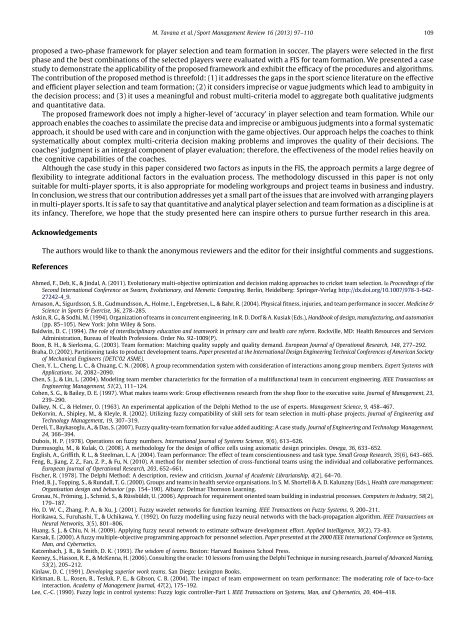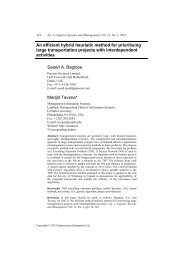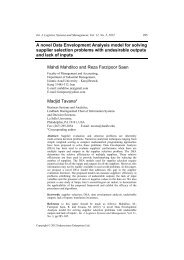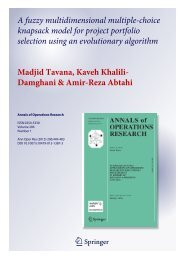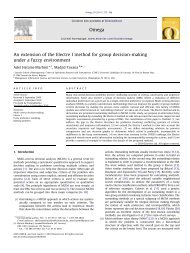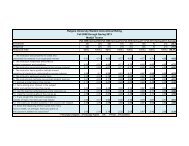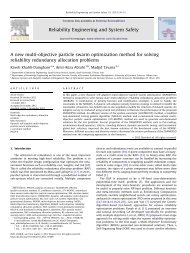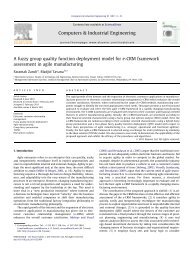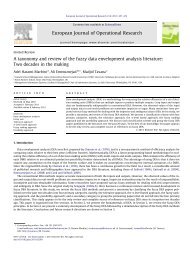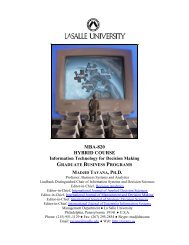A fuzzy inference system with application to player selection and ...
A fuzzy inference system with application to player selection and ...
A fuzzy inference system with application to player selection and ...
Create successful ePaper yourself
Turn your PDF publications into a flip-book with our unique Google optimized e-Paper software.
M. Tavana et al. / Sport Management Review 16 (2013) 97–110 109proposed a two-phase framework for <strong>player</strong> <strong>selection</strong> <strong>and</strong> team formation in soccer. The <strong>player</strong>s were selected in the firstphase <strong>and</strong> the best combinations of the selected <strong>player</strong>s were evaluated <strong>with</strong> a FIS for team formation. We presented a casestudy <strong>to</strong> demonstrate the applicability of the proposed framework <strong>and</strong> exhibit the efficacy of the procedures <strong>and</strong> algorithms.The contribution of the proposed method is threefold: (1) it addresses the gaps in the sport science literature on the effective<strong>and</strong> efficient <strong>player</strong> <strong>selection</strong> <strong>and</strong> team formation; (2) it considers imprecise or vague judgments which lead <strong>to</strong> ambiguity inthe decision process; <strong>and</strong> (3) it uses a meaningful <strong>and</strong> robust multi-criteria model <strong>to</strong> aggregate both qualitative judgments<strong>and</strong> quantitative data.The proposed framework does not imply a higher-level of ‘accuracy’ in <strong>player</strong> <strong>selection</strong> <strong>and</strong> team formation. While ourapproach enables the coaches <strong>to</strong> assimilate the precise data <strong>and</strong> imprecise or ambiguous judgments in<strong>to</strong> a formal <strong>system</strong>aticapproach, it should be used <strong>with</strong> care <strong>and</strong> in conjunction <strong>with</strong> the game objectives. Our approach helps the coaches <strong>to</strong> think<strong>system</strong>atically about complex multi-criteria decision making problems <strong>and</strong> improves the quality of their decisions. Thecoaches’ judgment is an integral component of <strong>player</strong> evaluation; therefore, the effectiveness of the model relies heavily onthe cognitive capabilities of the coaches.Although the case study in this paper considered two fac<strong>to</strong>rs as inputs in the FIS, the approach permits a large degree offlexibility <strong>to</strong> integrate additional fac<strong>to</strong>rs in the evaluation process. The methodology discussed in this paper is not onlysuitable for multi-<strong>player</strong> sports, it is also appropriate for modeling workgroups <strong>and</strong> project teams in business <strong>and</strong> industry.In conclusion, we stress that our contribution addresses yet a small part of the issues that are involved <strong>with</strong> arranging <strong>player</strong>sin multi-<strong>player</strong> sports. It is safe <strong>to</strong> say that quantitative <strong>and</strong> analytical <strong>player</strong> <strong>selection</strong> <strong>and</strong> team formation as a discipline is atits infancy. Therefore, we hope that the study presented here can inspire others <strong>to</strong> pursue further research in this area.AcknowledgementsThe authors would like <strong>to</strong> thank the anonymous reviewers <strong>and</strong> the edi<strong>to</strong>r for their insightful comments <strong>and</strong> suggestions.ReferencesAhmed, F., Deb, K., & Jindal, A. (2011). Evolutionary multi-objective optimization <strong>and</strong> decision making approaches <strong>to</strong> cricket team <strong>selection</strong>. In Proceedings of theSecond International Conference on Swarm, Evolutionary, <strong>and</strong> Memetic Computing. Berlin, Heidelberg: Springer-Verlag http://dx.doi.org/10.1007/978-3-642-27242-4_9.Arnason, A., Sigurdsson, S. B., Gudmundsson, A., Holme, I., Engebretsen, L., & Bahr, R. (2004). Physical fitness, injuries, <strong>and</strong> team performance in soccer. Medicine &Science in Sports & Exercise, 36, 278–285.Askin, R. G., & Sodhi, M. (1994). Organization of teams in concurrent engineering. In R. D. Dorf & A. Kusiak (Eds.), H<strong>and</strong>book of design, manufacturing, <strong>and</strong> au<strong>to</strong>mation(pp. 85–105). New York: John Wiley & Sons.Baldwin, D. C. (1994). The role of interdisciplinary education <strong>and</strong> teamwork in primary care <strong>and</strong> health care reform. Rockville, MD: Health Resources <strong>and</strong> ServicesAdministration, Bureau of Health Professions. Order No. 92-1009(P).Boon, B. H., & Sierksma, G. (2003). Team formation: Matching quality supply <strong>and</strong> quality dem<strong>and</strong>. European Journal of Operational Research, 148, 277–292.Braha, D. (2002). Partitioning tasks <strong>to</strong> product development teams. Paper presented at the International Design Engineering Technical Conferences of American Societyof Mechanical Engineers (DETC’02 ASME).Chen, Y. L., Cheng, L. C., & Chuang, C. N. (2008). A group recommendation <strong>system</strong> <strong>with</strong> consideration of interactions among group members. Expert Systems <strong>with</strong>Applications, 34, 2082–2090.Chen, S. J., & Lin, L. (2004). Modeling team member characteristics for the formation of a multifunctional team in concurrent engineering. IEEE Transactions onEngineering Management, 51(2), 111–124.Cohen, S. G., & Bailey, D. E. (1997). What makes teams work: Group effectiveness research from the shop floor <strong>to</strong> the executive suite. Journal of Management, 23,239–290.Dalkey, N. C., & Helmer, O. (1963). An experimental <strong>application</strong> of the Delphi Method <strong>to</strong> the use of experts. Management Science, 9, 458–467.DeKorvin, A., Shipley, M., & Kleyle, R. (2002). Utilizing <strong>fuzzy</strong> compatibility of skill sets for team <strong>selection</strong> in multi-phase projects. Journal of Engineering <strong>and</strong>Technology Management, 19, 307–319.Dereli, T., Baykasoglu, A., & Das, S. (2007). Fuzzy quality-team formation for value added auditing: A case study. Journal of Engineering <strong>and</strong> Technology Management,24, 366–394.Dubois, H. P. (1978). Operations on <strong>fuzzy</strong> numbers. International Journal of Systems Science, 9(6), 613–626.Durmusoglu, M., & Kulak, O. (2008). A methodology for the design of office cells using axiomatic design principles. Omega, 36, 633–652.English, A., Griffith, R. L., & Steelman, L. A. (2004). Team performance: The effect of team conscientiousness <strong>and</strong> task type. Small Group Research, 35(6), 643–665.Feng, B., Jiang, Z. Z., Fan, Z. P., & Fu, N. (2010). A method for member <strong>selection</strong> of cross-functional teams using the individual <strong>and</strong> collaborative performances.European Journal of Operational Research, 203, 652–661.Fischer, R. (1978). The Delphi Method: A description, review <strong>and</strong> criticism. Journal of Academic Librarianship, 4(2), 64–70.Fried, B. J., Topping, S., & Rundall, T. G. (2000). Groups <strong>and</strong> teams in health service organisations. In S. M. Shortell & A. D. Kalunzny (Eds.), Health care management:Organisation design <strong>and</strong> behavior (pp. 154–190). Albany: Delmar Thomson Learning.Gronau, N., Fröming, J., Schmid, S., & Rüssbüldt, U. (2006). Approach for requirement oriented team building in industrial processes. Computers in Industry, 58(2),179–187.Ho, D. W. C., Zhang, P. A., & Xu, J. (2001). Fuzzy wavelet networks for function learning. IEEE Transactions on Fuzzy Systems, 9, 200–211.Horikawa, S., Furuhashi, T., & Uchikawa, Y. (1992). On <strong>fuzzy</strong> modelling using <strong>fuzzy</strong> neural networks <strong>with</strong> the back-propagation algorithm. IEEE Transactions onNeural Networks, 3(5), 801–806.Huang, S. J., & Chiu, N. H. (2009). Applying <strong>fuzzy</strong> neural network <strong>to</strong> estimate software development effort. Applied Intelligence, 30(2), 73–83.Karsak, E. (2000). A <strong>fuzzy</strong> multiple-objective programming approach for personnel <strong>selection</strong>. Paper presented at the 2000 IEEE International Conference on Systems,Man, <strong>and</strong> Cybernetics.Katzenbach, J. R., & Smith, D. K. (1993). The wisdom of teams. Bos<strong>to</strong>n: Harvard Business School Press.Keeney, S., Hasson, R. E., & McKenna, H. (2006). Consulting the oracle: 10 lessons from using the Delphi Technique in nursing research. Journal of Advanced Nursing,53(2), 205–212.Kinlaw, D. C. (1991). Developing superior work teams. San Diego: Lexing<strong>to</strong>n Books.Kirkman, B. L., Rosen, B., Tesluk, P. E., & Gibson, C. B. (2004). The impact of team empowerment on team performance: The moderating role of face-<strong>to</strong>-faceinteraction. Academy of Management Journal, 47(2), 175–192.Lee, C.-C. (1990). Fuzzy logic in control <strong>system</strong>s: Fuzzy logic controller-Part I. IEEE Transactions on Systems, Man, <strong>and</strong> Cybernetics, 20, 404–418.


